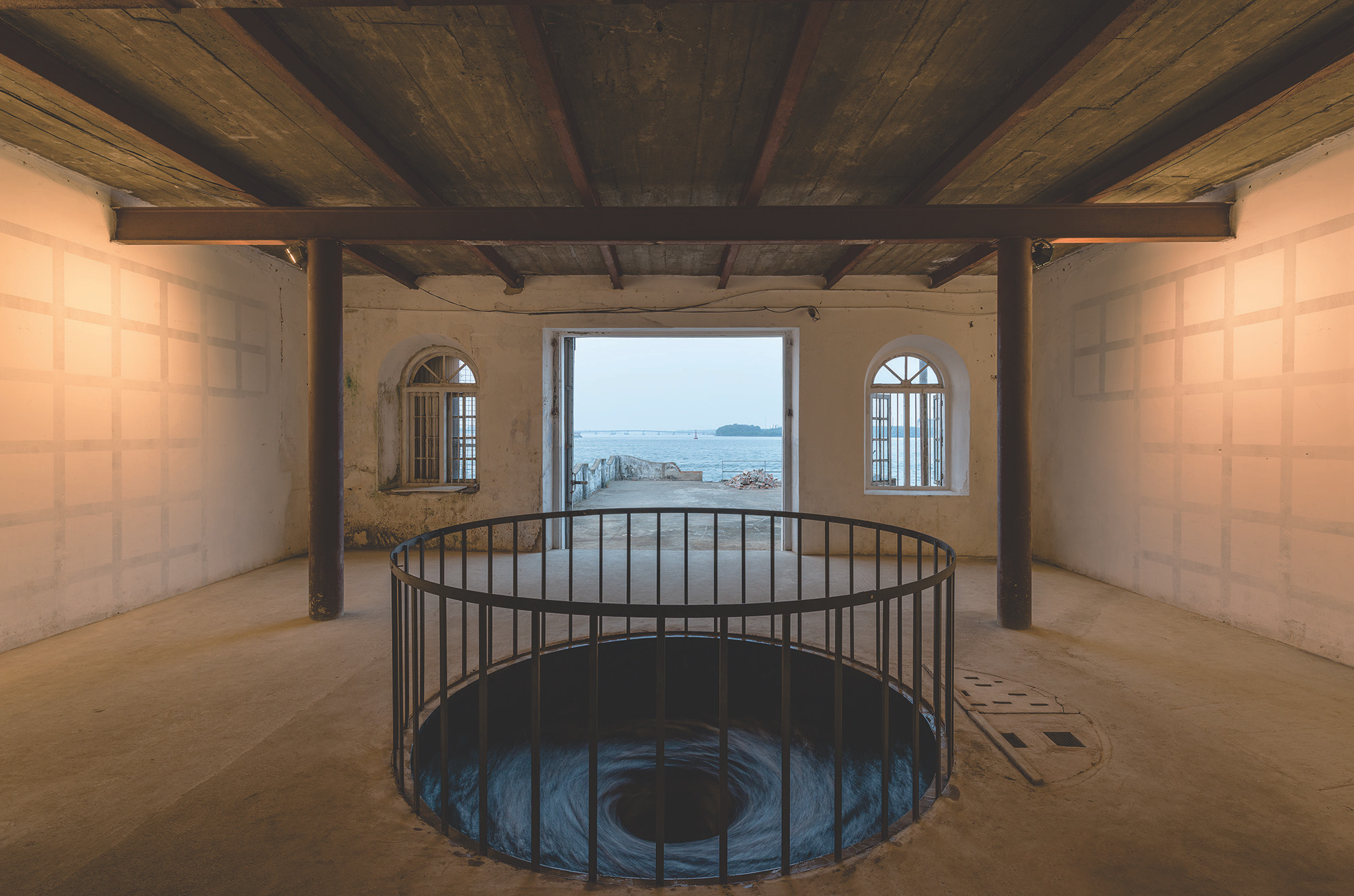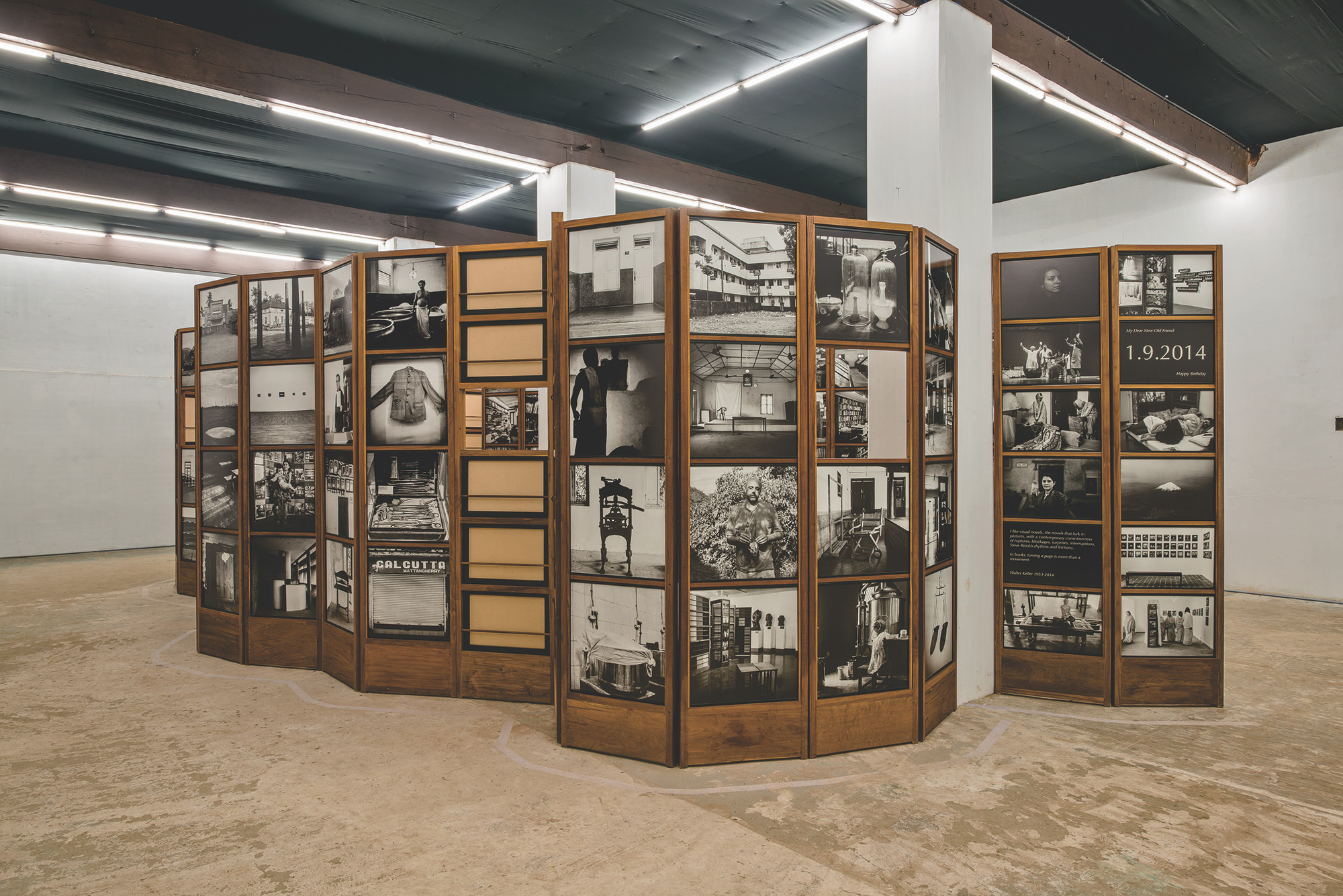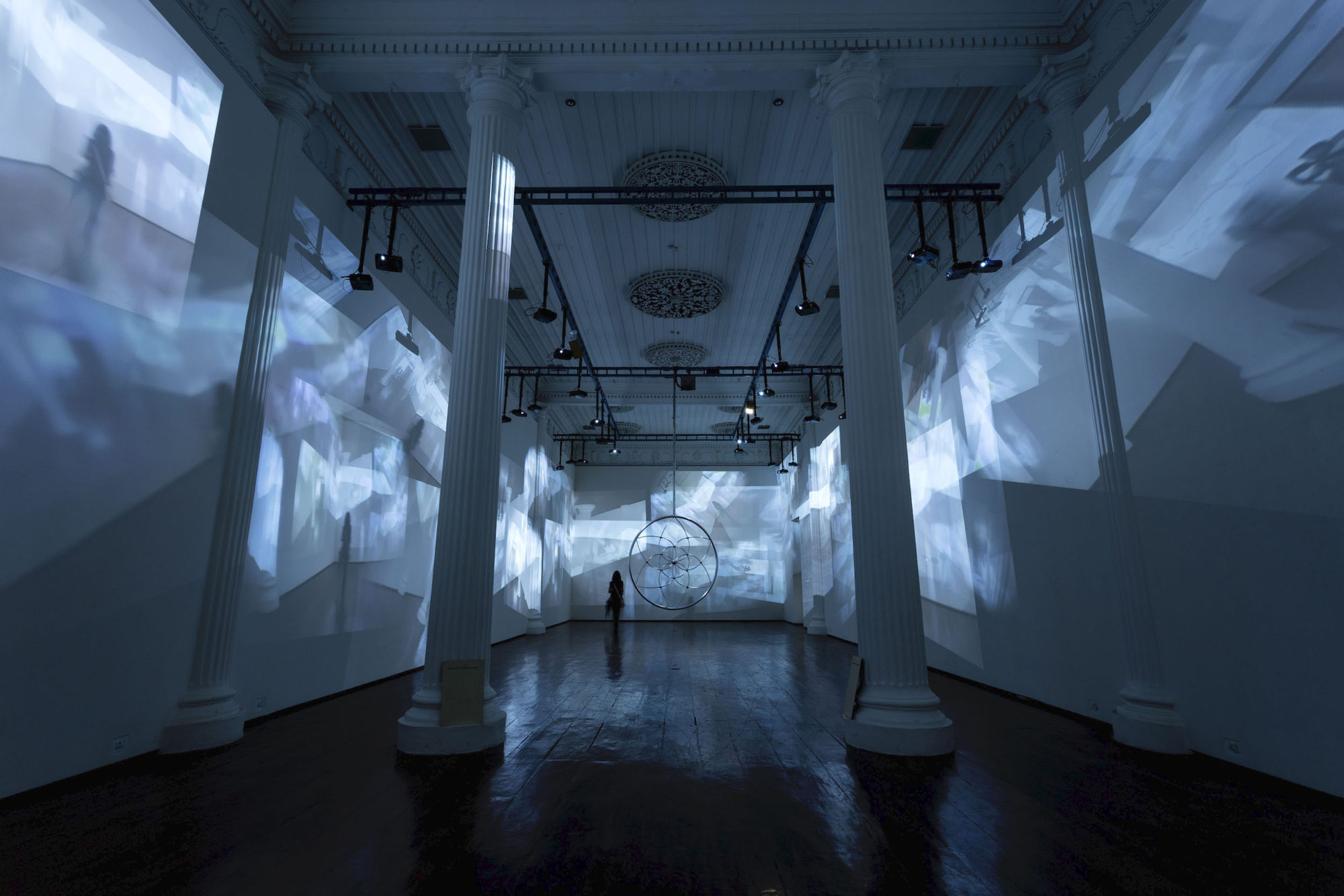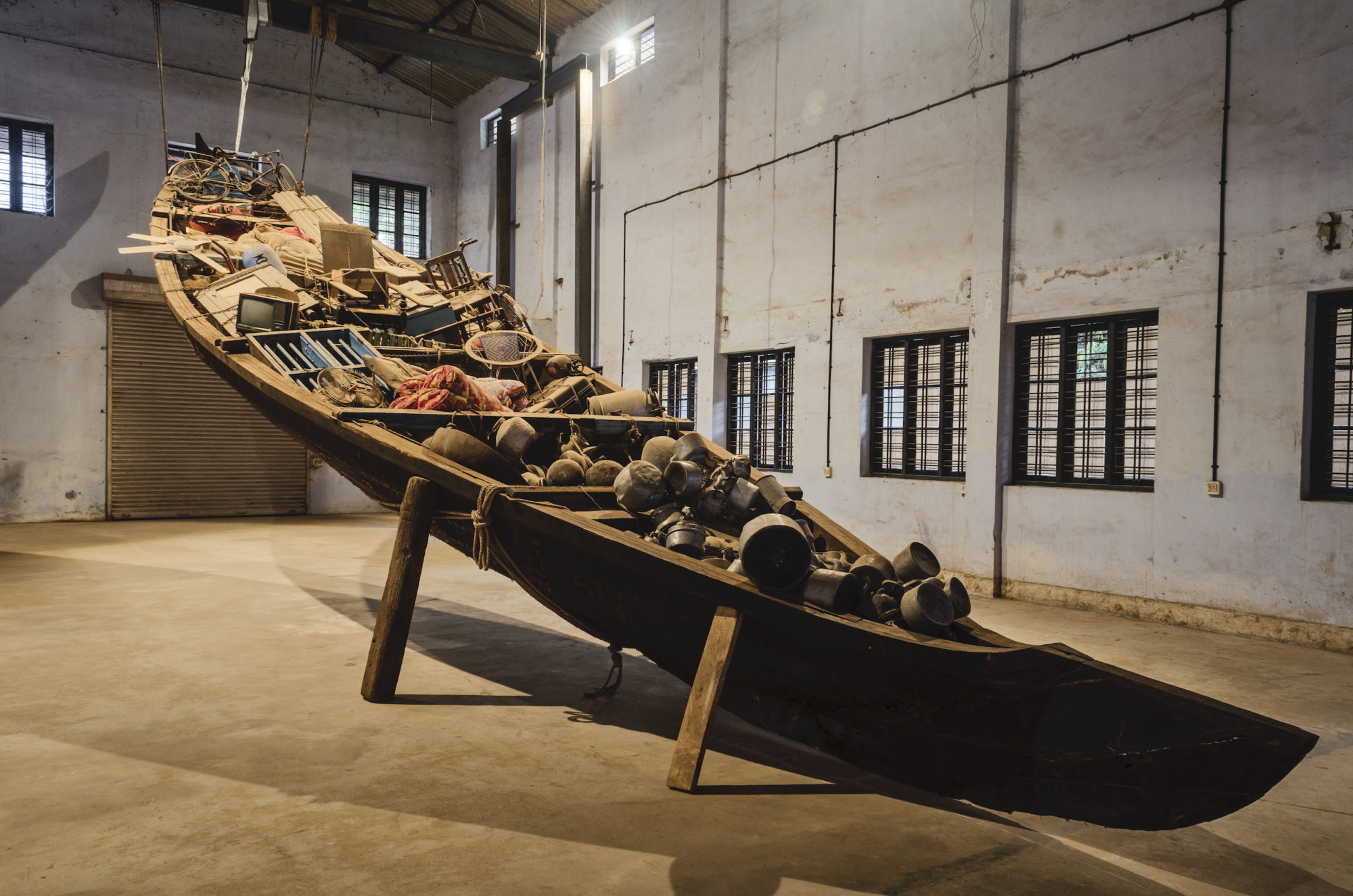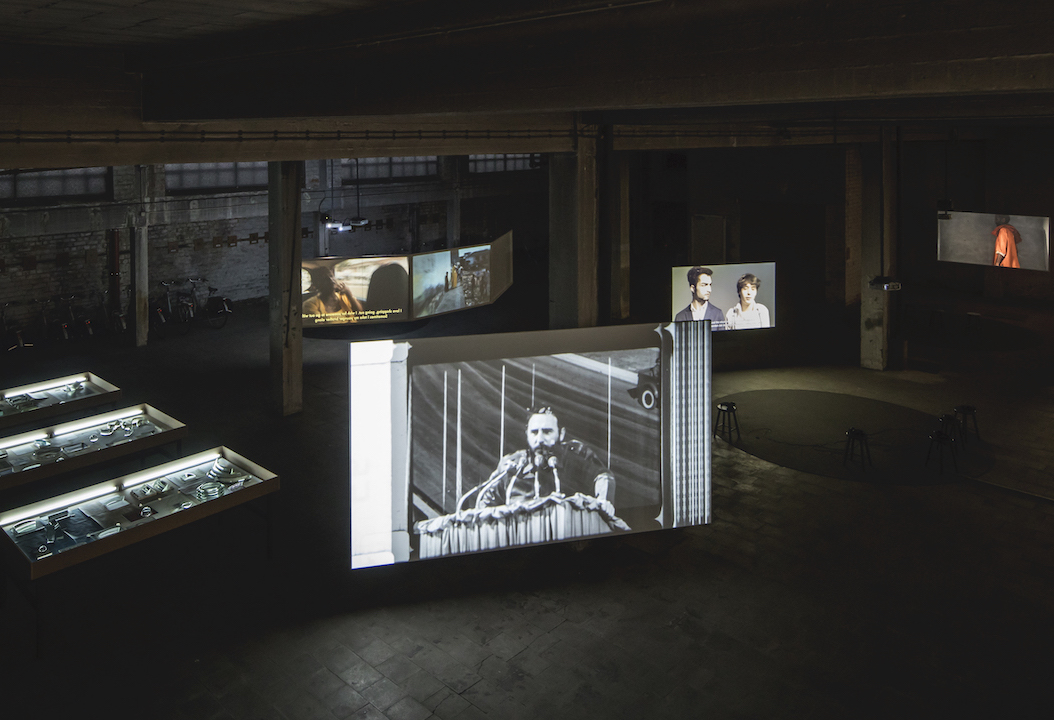Bose Krishnamachari
Of the People, by the People, and for the People
- 17.12.2018
Alex Seton, Refuge, 2015. Bianca carrara marble, eyelets and palette.110 x 120 x 170 cm. Installation view at the TKM Warehouse, Mattancheri.
All images courtesy of the Kochi Biennale Foundation.
When I was approached to write about the Kochi-Muziris Biennale, I was not sure that I could add to what has already been said about it since its inception. Three editions have been successfully produced, putting a relatively unknown city in the southern Indian state of Kerala on the global art map. Reams have been written about both the event and its growing importance as a South Asian cultural vehicle fostering local, national and international relationships. It has also evolved very organically into a “People’s Biennale,” which makes us on the Biennale team truly proud.
Alex Seton, Refuge, 2015. Bianca carrara marble, eyelets and palette.110 x 120 x 170 cm. Installation view at the TKM Warehouse, Mattancheri.
All images courtesy of the Kochi Biennale Foundation.
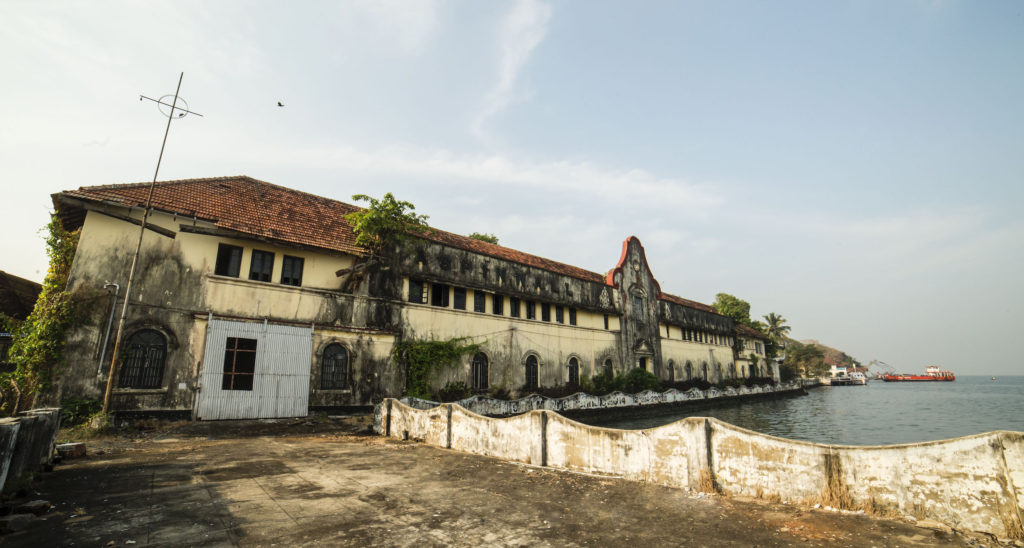
Aspinwall House, the largest venue of the Kochi-Muziris Biennale.
The Kochi-Muziris Biennale may also be the only biennial in the world that has been, and still is, conceptualised, designed and executed by practising artists. More importantly, it also intervened in the discourse surrounding the biennial format, which was gaining in intensity and urgency at the time of its conception. With emphasis on the role of the artist-curator in biennial making and on popular participation, the Kochi-Muziris Biennale offered a new perspective and direction.
A 2010 conversation between three artists (Riyas Komu, Jyothi Basu and myself) and M.A. Baby, who was then cultural minister of Kerala, launched the idea of a biennial. By the time it opened on December 12, 2012 (12.12.12), the Kochi-Muziris Biennale showed the world new possibilities. A biennial could both be rooted in the cultural ethos nurtured by the local community and invite the richness of international interventions in contemporary art. From the sliver of land that oversees the meeting of the backwaters with the sea, Kochi now stands firmly as the site of global art in India. Nearby, the legacy of Muziris resonates, just as its ancient port is being excavated.
Needless to say, an event of this nature and stature is bound to be entangled with politics and economics. The state of Kerala – particularly the city of Kochi – has, for centuries, been a cosmopolitan hub shaped by multiculturalism, tourism and international trade. Since antiquity, when it became the precarious epicentre of the spice route, it has enjoyed a trade economy.
In 1957, the people of the Indian state of Kerala became the first group to democratically elect a communist government. Kerala’s unusually sophisticated education system helped it attain the highest literacy rate in India. Kerala is also remarkable for the relative absence of sectarian conflicts. Since its independence from the United Kingdom in 1947, religious and ethnic violence continues to affect several parts of India. Such sectarian violence, however, has been conspicuously rare in Kerala.
The Kerala model of development, first outlined in a study done for the UN at the Centre for Development Studies in Thiruvananthapuram, Kerala, continues to be a reference for students of social economics as the state enjoys positive ratings on social indices like literacy, maternal mortality rates and nutrition levels, despite its low per capita income. This model, which also elucidates the context of the Biennale, has been defined as:
• A set of high material quality-of-life indicators coinciding with low per capita incomes, both distributed across nearly the entire population of Kerala.
• A set of wealth and resource redistribution programmes that have largely brought about the high material quality-of-life indicators.
• High levels of political participation and activism among ordinary people along with substantial numbers of dedicated leaders at all levels. Kerala’s mass activism and committed communist cadre were able to function within a largely democratic structure, which they continually reinforce.
Such remarkable local conditions should have provided fertile ground for our project to present India’s first biennial in Kochi. When we set out to produce this biennial, we only had art in mind. We naively thought everyone would be on the same page. Everything was going swimmingly until a Malayalam magazine published a story in late 2011. The Kerala state government had set aside 50 million rupees (or approximately 680,000 USD) for the Kochi-Muziris Biennale, and the article claimed that the Biennale was a smokescreen for the organisers to pilfer the money. Quickly, our carefully laid out plans, beginning with our statement of purpose for holding the biennial in Kerala, were hijacked by a series of events.
Aspinwall House, the largest venue of the Kochi-Muziris Biennale.
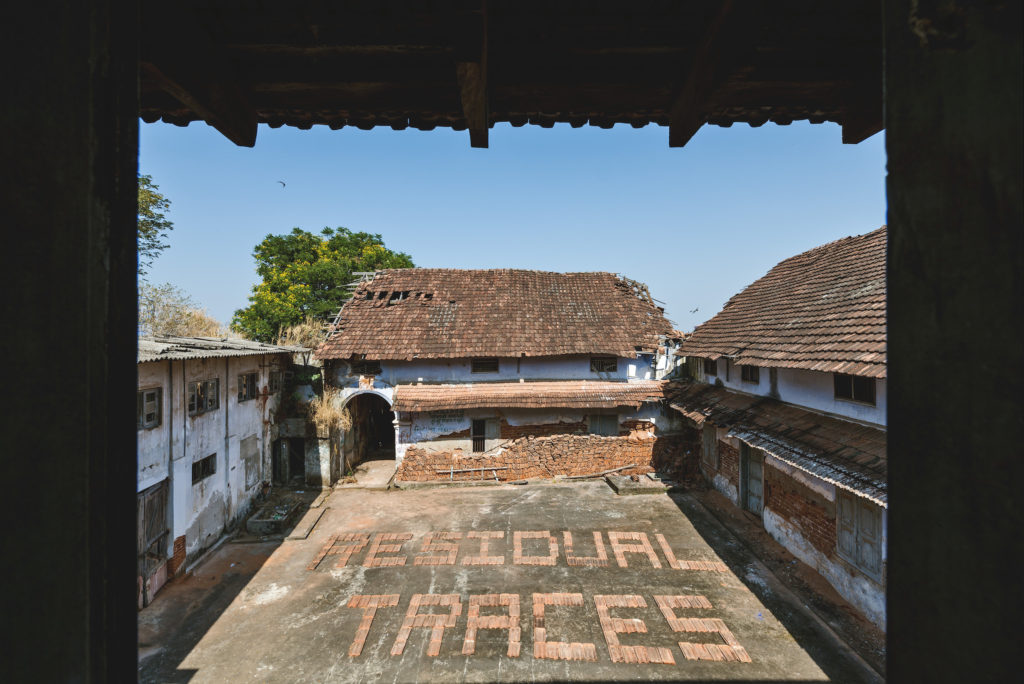
UBIK, Past Present Past II, 2012 Found terracotta tiles and debris. Dimensions variable. Installation view at Dutch Warehouse, Fort Kochi.
Alleging financial misappropriation, a group of detractors and decriers questioned our motivations, which had been demonstrated with our first project: as a precursor to the Biennale, we had embarked on the renovation of Darbar Hall, an exhibition space for which the Lalit Kala Akademi, the government agency for the development of visual arts in Kerala, was responsible. We had decided to use the first installment of the funds provided by the state government to renovate the dilapidated building, bringing it up to international standards. This move came under scrutiny, prompted by misleading media reports of corruption and overspending of public funds. Misinformation circulating in the public domain put all of us in the dock, to a certain extent, but we remained unfazed by all the commotion.
The opposition spurred us on. We redoubled our efforts as the opening neared. It was an important juncture for us. We began looking for support elsewhere. Since our project was premised on a rejection of elitism, we campaigned to connect with the local community directly. We printed brochures in Malayalam and distributed them to the public. Posters went up all around the city – on buses, auto rickshaws and taxis as well as in public squares – showing photographs of ordinary people, such as drivers, hawkers, pedestrians, school children and so on, with one slogan: “It’s Our Bienniale.”
We held lecture-demonstrations, presentations, skits and literary programmes in schools and colleges to spread the word. That did wonders for us. Support came from all quarters, most importantly from the local people. Offers of help flooded in and a corps of volunteers answered our call. These young women and men who came together for, and produce, the Biennale continue to be our bedrock. No forces of politics and economics can get in the way of that continuum, and the destructive opposition has now retreated.
We have come a long way since then. The Biennale is now preparing its fourth edition with much confidence, humility and a growing sense of responsibility. The Kochi-Muziris Biennale has become an important destination for the international art community. Swollen with pride, the local community has not only adopted the event but taken ownership of it. Today, the word ‘biennale’ has entered the Malayalam lexicon and found a secure place in the popular imagination. Nothing can dislocate it from either of those places.
UBIK, Past Present Past II, 2012 Found terracotta tiles and debris. Dimensions variable. Installation view at Dutch Warehouse, Fort Kochi.
ABOUT THE AUTHOR
Born in Kerala, southern India, Bose Krishnamachari is a co-founder, director and president of the Kochi Biennale Foundation. He was a co-curator of the Kochi-Muziris Biennale in 2012 and the curator of the inaugural Yinchuan Biennale in 2016.

